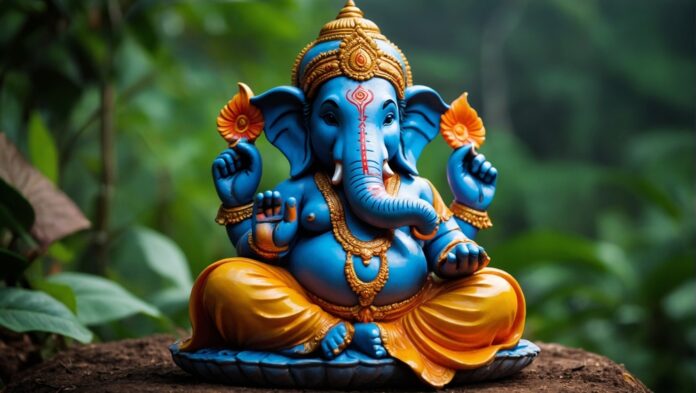Table of Contents
ToggleWhy We Celebrate Ganesh Festival: A Comprehensive Guide
The Ganesh Festival, also known as Ganesh Chaturthi, is one of the most widely celebrated Hindu festivals. Dedicated to Lord Ganesha, the elephant-headed deity who symbolizes wisdom, prosperity, and good fortune, this festival is marked by vibrant celebrations across India and among Hindu communities worldwide. This blog explores the significance of the Ganesh Festival, its historical origins, rituals, and the cultural impact it has on society.
Also Read: Ganesh Chaturthi 2025: Date, History, Celebration
The Significance of Lord Ganesha
Who is Lord Ganesha?
Lord Ganesha, the son of Shiva and Parvati, is one of the most beloved deities in Hinduism. He is easily recognizable by his elephant head, which symbolizes wisdom, understanding, and a discriminating intellect. His large, rounded body signifies abundance and the ability to overcome obstacles.
Symbolism of Ganesha
The elephant head of Ganesha represents the ability to think big and act with wisdom. His four arms hold various objects that signify different aspects of life:
- Axe: To cut off attachments and desires.
- Rope: To pull devotees closer to their goals.
- Sweet Modak: Represents the rewards of a good life.
- Broken Tusk: Symbolizes sacrifice and the ability to face adversity.
Historical Origins of Ganesh Festival
Ancient Roots
The origins of Ganesh Chaturthi can be traced back to ancient Hindu traditions. The festival is believed to have been celebrated in different forms for centuries. However, it gained prominence in the 19th century due to the efforts of the Maratha ruler, Shivaji Maharaj.
Modern Revival
The modern form of Ganesh Chaturthi was popularized by the Indian freedom fighter Bal Gangadhar Tilak in the late 19th century. Tilak used the festival as a means to bring people together and foster a sense of unity and nationalism during the struggle for independence. He transformed Ganesh Chaturthi from a private family celebration into a grand public event.
Rituals and Celebrations
Preparations Before the Festival
The preparation for Ganesh Chaturthi begins weeks before the actual festival. Homes and public spaces are adorned with decorations, and elaborate Ganesh idols are crafted. These idols can range from small clay figures to enormous, intricately designed statues.
Ganesh Chaturthi Day
The festival typically lasts for ten days, beginning on Chaturthi, the fourth day of the Hindu lunar calendar month of Bhadrapada. The main rituals include:
- Ganesh Idol Installation: Devotees bring home Ganesh idols and place them in beautifully decorated pandals (temporary stages).
- Pooja (Worship): Various rituals are performed, including offering flowers, sweets, and prayers. Devotees sing devotional songs and chant mantras to honor Lord Ganesha.
- Visarjan (Immersion): On the final day, the idol is taken in a grand procession to a water body, where it is immersed. This ritual signifies the deity’s return to his heavenly abode and symbolizes the cycle of creation and dissolution.
Cultural Activities
During the festival, cultural events such as music, dance performances, and theatrical plays are held. These activities reflect regional traditions and add to the festive atmosphere.
Regional Variations
Maharashtra
In Maharashtra, Ganesh Chaturthi is celebrated with great fervor. Public pandals are set up, and large processions are organized. The festival is marked by community gatherings, cultural performances, and elaborate decorations.
Karnataka
In Karnataka, the festival is celebrated with traditional rituals and folk performances. The immersion processions are known for their vibrant and colorful displays.
Andhra Pradesh and Telangana
The celebrations in Andhra Pradesh and Telangana include special prayers and offerings. Devotees often prepare traditional sweets and delicacies as part of the festivities.
Environmental and Social Impact
Environmental Concerns
In recent years, there has been increasing awareness about the environmental impact of the festival. The immersion of idols made from non-biodegradable materials can pollute water bodies. To address this, there is a growing movement towards using eco-friendly idols made from clay and natural materials.
Community and Social Impact
The Ganesh Festival fosters a sense of community and unity. It brings people together, irrespective of their background, to celebrate a common cultural and religious heritage. The festival also provides a platform for artists and craftsmen to showcase their work.
Why Ganesh Chaturthi is celebrated for 10 days
Ganesh Chaturthi is traditionally celebrated over 10 days, culminating in the final day known as Anant Chaturdashi. The duration of the festival is significant for several reasons, both spiritual and cultural:
- Mythological Significance: According to Hindu mythology, it is believed that Lord Ganesha stays with his devotees for 10 days before returning to Mount Kailash. This period is marked by intense devotion and worship.
- Gradual Spiritual Awakening: The 10-day celebration symbolizes a spiritual journey. Devotees begin by invoking Ganesha’s presence, then gradually immerse themselves in prayers and rituals that purify their minds and souls.
- Completion of Rituals: The 10-day period allows for the complete performance of various rituals, which are meant to appease and honor Lord Ganesha. Each day has specific prayers and offerings that help fulfill the religious duties of the devotees.
- Symbolic of Life’s Cycles: The 10-day festival represents the cycle of birth, life, and death. The installation of the idol symbolizes creation, daily rituals symbolize life, and the immersion (Visarjan) symbolizes dissolution.
- Harvest Season: Ganesh Chaturthi often coincides with the end of the monsoon season and the beginning of the harvest. The 10-day celebration is also a time for thanking the deity for a bountiful harvest and seeking blessings for future prosperity.
- Cultural and Social Gatherings: Over 10 days, communities come together to celebrate with music, dance, and cultural performances. This extended period allows for significant social interaction and the strengthening of community bonds.
- Time for Reflection: The festival provides devotees with time to reflect on their actions, seek forgiveness for past mistakes, and resolve to lead a better life. Each day of worship reinforces these values.
- Economic Impact: The 10-day celebration supports local economies, especially artisans and craftsmen who create idols and decorations. The extended duration allows for sustained economic activity during the festival.
- Educational and Cultural Programs: Many educational and cultural programs are organized during Ganesh Chaturthi. The 10 days provide ample time for schools, communities, and organizations to hold events that educate people about Lord Ganesha’s significance.
- Final Daty on Anant Chaturdashi: The final day, Anant Chaturdashi, is the climax of the festival. The immersion of Ganesha idols in water bodies symbolizes the return of Ganesha to his divine abode, concluding the cycle of celebration and devotion.
10 Key Points About Ganesh Chaturthi
- Celebration of Lord Ganesha: Ganesh Chaturthi is dedicated to Lord Ganesha, the god of wisdom, prosperity, and new beginnings. He is revered as the remover of obstacles.
- Historical Roots: The festival has ancient origins but was popularized in its current form by Bal Gangadhar Tilak in the 19th century as a way to unite people during the Indian independence movement.
- Installation of Idols: The festival begins with the installation of Ganesha idols in homes and public pandals. These idols vary in size and are often intricately decorated.
- 10-Day Celebration: The festival lasts for 10 days, during which devotees perform various rituals, offer prayers, and seek blessings from Lord Ganesha.
- Visarjan (Immersion): On the 10th day, the idols are immersed in water bodies. This ritual, known as Visarjan, signifies Ganesha’s return to Mount Kailash and the cycle of creation and dissolution.
- Regional Variations: While Ganesh Chaturthi is widely celebrated across India, it is particularly grand in Maharashtra, Karnataka, Andhra Pradesh, and Tamil Nadu, each with its own unique traditions.
- Eco-Friendly Movements: In recent years, there has been a shift towards eco-friendly celebrations, with many people opting for clay idols and natural decorations to minimize environmental impact.
- Community and Cultural Events: The festival is a time for community bonding, with cultural events, music, dance performances, and charity work taking center stage during the 10 days.
- Festive Foods: Modak, a sweet dumpling, is the favorite food of Lord Ganesha and is widely prepared during the festival along with other traditional delicacies like Puran Poli, Ladoo, and Vundrallu.
- Global Celebrations: Ganesh Chaturthi is not just limited to India; it is celebrated by Hindu communities worldwide, including in countries like the USA, UK, Australia, and Canada, reflecting the global significance of the festival.
Looking for a safe and comfortable way to travel? AbhiBus has you covered! Book your tickets now and take advantage of our top-rated bus services.
Conclusion
The Ganesh Festival is more than just a religious event; it is a vibrant celebration of life, unity, and devotion. Through its rich history, diverse rituals, and cultural significance, the festival reflects the deep reverence for Lord Ganesha and his role in guiding and protecting his devotees. As we celebrate Ganesh Chaturthi, we not only honor a cherished deity but also embrace the values of wisdom, prosperity, and harmony that Lord Ganesha represents.





